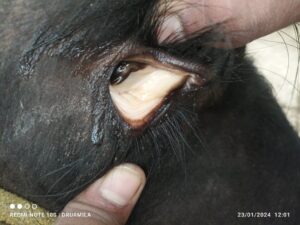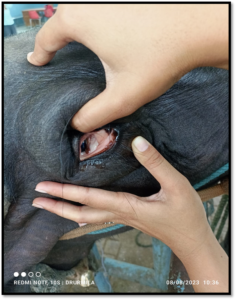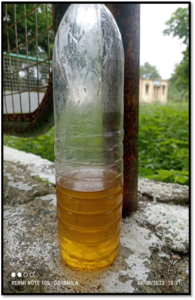THERAPEUTIC MANAGEMENT OF POST-PARTURIENT HEMOGLOBINURIA IN A BUFFALO
Urmila Wakade1, Meera Sakhare2, Samiksha Lokhande1
- V.Sc. Scholar 2. I/c Professor & Head
Department of Veterinary Medicine
College of Veterinary and Animal Sciences, Parbhani.
MAFSU, Nagpur
Abstract
A 5-year-old buffalo with third parity presented with a complain of dark reddish-brown urine, inappetance and decreased milk production. On the basis of detailed clinical, haematological and biochemical examination revealed a case of for post-parturient hemoglobinuria (PPH) in buffaloe. The case is discussed in details as below.
Introduction
Post parturient haemoglobinuria is also known as puerperal haemoglobinuria, nutritional haemoglobinuria, phosphorus deficiency haemoglobinuria or hypophosphatemia (Randhawa and Chand, 2011; Sridhar and Rakeshkumar, 2008). PPH is a sporadic metabolic disease caused by phosphorous deficiency that affects adult buffaloes worldwide during both postpartum and/or advanced stages of pregnancy. PPH clinically characterized by intravascular hemolysis, hemoglobinuria, and anemia (Bhat, 2010).
The illness is typical in lactating animals from third to sixth parity (Constable et al., 2017). The levels of inorganic phosphate in blood are thought to indicate dietary phosphate intake and haemoglobin levels were assessed to determine the presence of anemia (Grunwaldt et al., 2005). Hypophosphatemia increases the risk of increased fragility in cells, reduces their ability to deform and inhibits the generation of ATP by erythrocytes (Wang et al., 1985). It is undefined that cause of erythrocyte breakdown in PPH that results in anemia and hemoglobinuria or might be as a result from bacterial hemolysis and blood parasites viz; Babesia, Anaplasma, etc. (Macwillims et al., 1982). Pregnant and nursing buffaloes must have their nutrition under control in order to prevent clinical illness. The current case reports successful therapeutic management of PPH in a buffalo.
Case history and observations
A 5-year-old buffalo with third parity was brought to Veterinary Clinical Complex, College of Veterinary and Animal Sciences, Parbhani. With a history of parturition 20 days back and the buffalo urine had a dark reddish brown colour with foam and a generalized weakness since three days. The other clinical findings were constipation, decreased milk output and inappetance. The animal was kept indoor and supplemented mostly with the green fodders. Clinical examination revealed pale mucous membranes (Fig.1), reddish-brown urine (Fig.2), heart rate 98 beats per minute, respiratory difficulty and a normal rectal temperature (100°F). The animal was in a normal posture and gait, skin coat reveled moderate dehydration. The illness was initially identified as postparturient hemoglobinuria related to dietary phosphorus deficiency and hypophosphatemia according to clinical symptoms.
|
|
||||||
| Fig.1 Pale conjunctival mucous membrane (BT) | Fig.2 Dark reddish brown urine (BT) | ||||||
|
|
||||||
| Fig.3 Pink coloured conjunctival mucous membrane (AT) | Fig.4 Normal urine colour (AT) |
Diagnosis
Prior to therapy, sample blood was collected into a tube containing EDTA for haematological analysis. Pretreatment samples such as urine, whole blood, and serum were also collected for estimation. Thin blood smears was prepared and stained with Giemsa’s stain and checked for blood parasites in the erythrocytes to differentiate with hemoprotozoal disease. The blood smear not revealed any hemoprotozoan parasites. Hematological results showed that anemia (decreased Hb), decreased packed cell volume (PCV), total leukocyte count (TLC), differential leukocyte count (DLC) and hemoglobinuria (Table 1). The biochemical analysis indicated that the buffaloes had a low level of serum inorganic phosphorus (2.1 mg/dl) as per Table 2.
Table 1: Hematological analysis
| Parameter | Before treatment | After treatment | Reference values |
| Hemoglobin (gm%) | 5.5 | 10.7 | 10-14 |
| PCV (%) | 17.5 | 31.7 | 30-40 |
| TLC (103 /cumm) | 6.8 | 7.2 | 6-12 |
| TEC(106/cumm) | 2.85 | 6.3 | 5.5-8.5 |
| Neutrophils (%) | 53 | 39 | 30-40 |
| Lymphocytes (%) | 38 | 64 | 50-65 |
| Eosinophils (%) | 02 | 02 | 1-2 |
Table 2: Biochemical analysis
| Parameters | Before treatment | After treatment | Reference values |
| Calcium ((mg/dl) | 7.94 | 10.7 | 9.7-12.4 |
| Phosphorus (mg/dl) | 2.1 | 5.3 | 5.6-6.5 |
Therapeutic management and Discussion
The buffalo was treated with, buffered preparation of sodium acid phosphate, inosine and sodium pyruvate (Novizac) @ 50 ml IV on first day followed by 25 ml IV with normal saline for next 2-5 days. In addition, ascorbic acid @ 15-20mg/kg IV as antioxidant for 5 days. Iron preparation 10 ml IM was given on alternate two days. Inj. B complex 15 ml IM and 20% Dextrose 500 ml IV given as a supportive treatment for 5 days. To maintain the serum phosphorus levels, 100 grams of powdered sodium acid phosphate was given orally for next five days. Urine colour and conjunctival mucous membrane after five days therapy was normal (Fig 4 and Fig 3).
Buffered preparation of sodium acid phosphate, inosine and sodium pyruvate was administered because it does not worsen the acidosis that usually occurs in case of hemoglobinuria. Addition of more inosine and sodium pyruvate helps to resolve Heinz bodies, rectify excessive oxidative stress and promote ATP generation in cells. Blood transfusion may be necessary in severe cases.
The phosphorus requirements of buffalo may vary depending on the various stages of growth, lactation, and pregnancy. Hypophosphatemia results in a decrease in red blood cell glycolysis and adenosine triphosphate (ATP) synthesis. A marked decline of the intracellular ATP concentration in red blood cells results in altered function and structure, a loss of the normal deformability of these cells, and an increase in osmotic fragility and hemolysis (Constable et al., 2017).
In present case study anorexia, decreased production of milk mild tachycardia, pale mucosa membranes and hemoglobinuria had shown by a buffalo. Additionally, serum biochemistry revealed serum phosphorus level (2.1mg/dl) was extremely low. Correcting hypophosphatemia in hemoglobinuric dairy cows and buffaloes is the fundamental goal of treatment. The standard treatment for hemoglobinuria in bovine has been to administer parenteral phosphate supplementation in the form of 30 g of monosodium dihydrogen phosphate (NaH2PO4) dissolved in 300 mL deionized water that is administered intravenously is often recommended (Constable et al., 2017).
Conclusion
On the basis of case study, we can conclude that in post-parturient hemoglobinuria in buffaloes, early diagnosis and prompt therapeutic management can improve the clinical and hemato-biochemical parameters.
References
- Bhat P.N. (2010) Buffalo Production. Stedium Press (India) Pvt. Ltd. Pp: 302-304.
- Constable PD, Kenneth W Hinchcliff, Stanley H done, Walter Grunberg (2017) Veterinary Medicine: A Textbook of the Diseases of Cattle, Horses, Sheep, pigs and Goats. Elsevier Publication. St. Louis Missouri.
- Grunwaldt E.G., Guevara J.C., Estevez O.R., Vicente A., Rousselle H, Alcuten N. (2005) Biochemical and haematological measurements in beef cattle in Mendoza Plain Rangelands (Argentina). Tropical Animal Health Production. 37:527-540
- Macwillims P.S., Searcy G.P., Bellamy J.E.C. (1982) Bovine postparturient haemoglobinuria. Canadian Veterinary Journal. 23:309-312.
- Randhawa, S. N. and Chand N. (2011) Production diseases of dairy animals. Proceedings of 29th ISVM Convention and National Symposium on ‘Recent development in diagnosis and therapeutics including applications of nanotechnology in Veterinary Medicine’ 17th-19th February: 28-49.
- Wang X.L., Gallagher C.H., McClure T.J., Reeve V.E., Canfield P.J. (1985) Bovine post-parturient haemoglobinuria: effect of inorganic phosphate on red cell metabolism. Research in Veterinary Science. 39(3):333-339.






